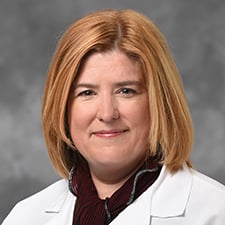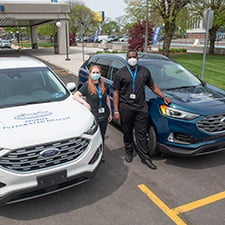Here’s what innovation looks like: Instead of having paramedics rush people to the hospital in an ambulance, Henry Ford Health has paramedics in SUVs go to people’s homes—mostly at pre-scheduled times—and work to keep them well enough to avoid the hospital.
Community “paramedicine” programs use paramedics to check on patients in their homes and provide varying levels of care. Often, the activities are limited to assessing the patients and reporting back to their physicians—or transporting patients to the hospital if they are in poor condition.
Henry Ford Health considers its “mobile integrated health” program a community paramedic approach on another level.
For starters, Henry Ford mobile integrated health medics are accompanied about one-third of the time in patients’ homes by a physician—via computer tablet. The remainder are handled independently with technology, communications and tools always on board, in the medics’ hands.
These more readily-available resources allow Henry Ford’s mobile integrated health medics to provide a higher level of care in the home.
One resource, their tablet loaded with Bluetooth attachments, allows the doctor to look into the patient’s ears and throat, and listen to their heart and lungs just as well they could with the equipment in their office, said Joyce Leon, MD, Henry Ford Health’s medical director for population health management.
“The key piece that makes this really work for us, and really fill the niche that's needed here is the physician oversight and partnership,” said Dr. Leon, an AMA member. Sean Drake, MD, is Henry Ford’s lead medical director for mobile integrated health, and Thomas Derkowski, MSc, is director of mobile integrated health.
“We do this in real time,” Dr. Leon said. “They assess, advise and come up with a treatment plan, and then our paramedics administer that right while they're at the patient's home.”
The paramedic’s tablet is integrated into Henry Ford Health EHR. That facilitates scheduling and communication with physicians and nonphysician clinicians and allows for the use of advanced digital diagnostic tools, which then permits paramedics to administer treatment under the direct supervision of a physician, Dr. Leon said.
Henry Ford Health is a member of the AMA Health System Program, an initiative that advances leadership and offers enterprise solutions to drive the future of medicine.
Dr. Leon detailed Henry Ford Health’s mobile integrated health program during a virtual meeting of the AMA Insight Network, which helps AMA Health System Program members gain early access to innovative ideas, get feedback from their peers, network, and learn about pilot opportunities.
Quick results expected
The program ramped up quickly with the pandemic’s onset and since April 2020, more than 3,500 patients have been seen in their homes by the program’s paramedics. “The point of this program is to reduce ED utilization,” Dr. Leon said, adding that this takes on extra value “in the context of COVID” where any relief provided to the emergency medicine staff is welcome.
There are financial challenges, especially as there is no code for this type of paramedic-provided service and “paramedics are not considered individuals who are able to bill,” she added. “This really eliminates the opportunity for you to bill fee for service in this particular area.”
Initial startup costs were offset “by a generous grant” from a Michigan-based insurance company and the donation of a leased SUV. The grant money, however, has been spent. Now the program’s value is reflected in the savings it has created. This is something payers entered into value-based contracts appreciate—including the Henry Ford Health’s own nonprofit Health Alliance Plan.
The program employs 13 paramedics, two supervisors, a director and four vehicles stocked with EKG machines, medications and other equipment. They are on the road daily, 9 a.m.–9 p.m. The paramedics work alone and see five to six patients a day.
“We're finding that the level of intensity is a lot more than what we originally anticipated, and so our paramedics are staying in the home longer than originally planned,” Dr. Leon said.
The program has cost $2.5 million but has generated an estimated $6 million in savings. The original estimate was that 30% of the visits would prevent an ED visit, but it the figure appears to be closer to 55%, with 5% seen as preventing hospitalization, Dr. Leon said.
Dr. Leon noted that patient buy-in grows considerably when they learn that the paramedics arrive in an SUV and won’t be parking an ambulance in their driveway.
“Many of our patients don't want an ambulance showing up to their house,” she said. “Once the patients realize that it’s just an SUV with ‘Henry Ford’ on the side of it, they are more than willing to have our paramedics come out to the homes.”





